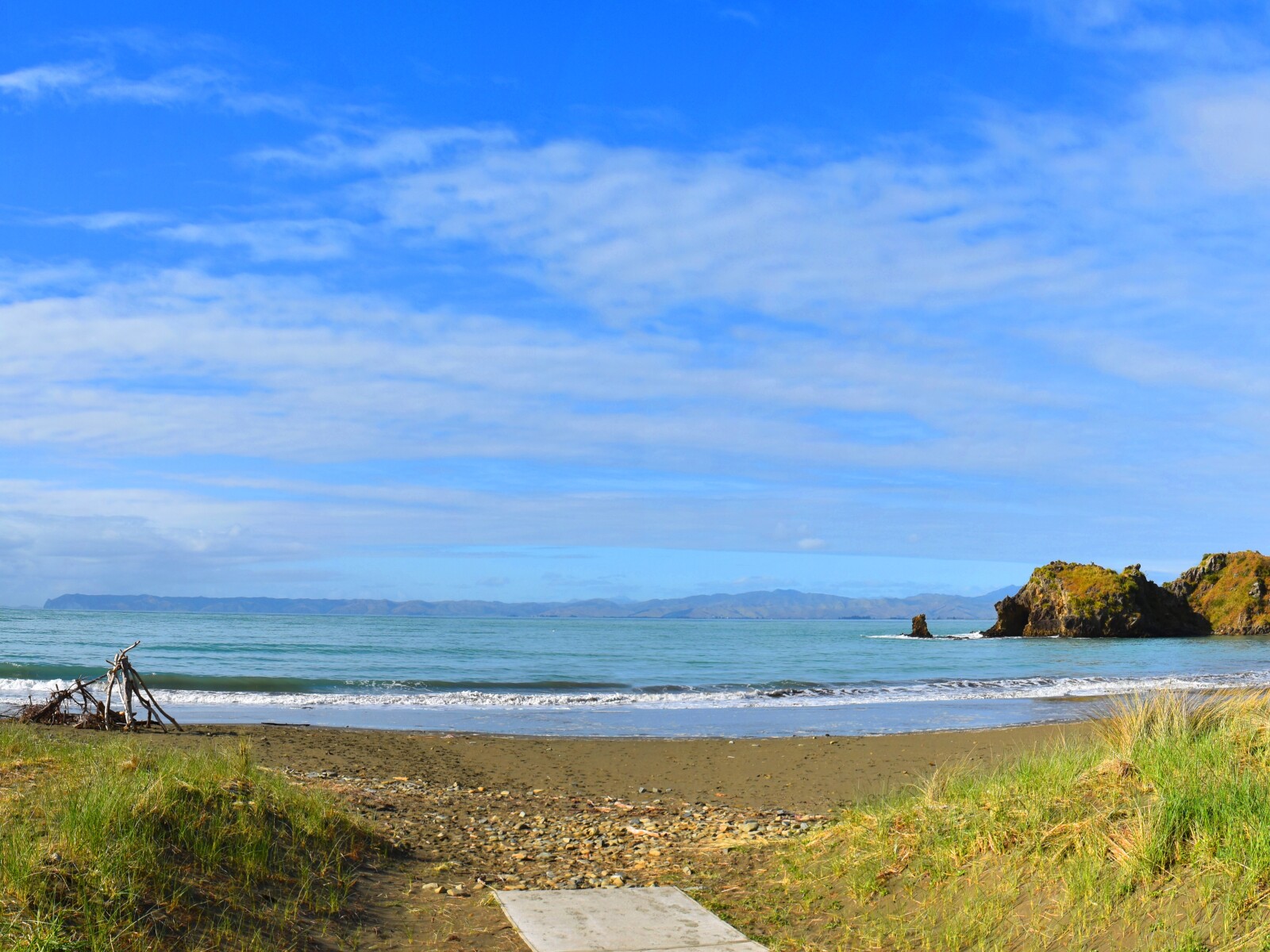Since 2014, this bay has been officially recognised by the name, Pukatea/ Whites Bay.
This dual name is a result of respective Treaty of Waitangi settlements between iwi from Te Tau Ihu (tribes from the top of the South Island) and the Crown.1
The Māori name for this bay probably refers to the pukatea tree, Laurelia novae-zelandiae. This tree is found throughout Marlborough and much of the North Island. It is a tall forest tree with thick, glossy leaves which have serrated edges.2
The bay has a significant history of occupation and has strong associations with the iwi, Rangitāne o Wairau. Until the late nineteenth century, the bay contained an extensive complex of cultivations, pā and dwellings and was also renowned for its eels and kaimoana or sea food.3
Māori tradition tells of a giant taniwha named Ngarara Huarau who lived in nearby caves known as, Te Ana Rangomai Papa, at Monkey Bay, a small adjacent bay.
Ngarara Huarau was greatly feared and terrorised local people, attacking them with acidic urine. Eventually, tired of fearing for their lives, Rongomaipapa, and his son Rangiatea, the builders of the main pā at Pukatea, killed the taniwha by spearing it through the neck.4
The European name for the bay, Whites Bay, was given in remembrance of Black Jack White, otherwise known as, Harper Ailsworth, an African American whaler and former slave. Ailsworth arrived in New Zealand on the barque, Shibboleth in 1839. His exact arrival in the bay in unknown but he is recorded as living in the area in 1843 when it was visited by the surveyor John Wallis Barnicoat. Ailsworth was known as a skilled rope maker and worked at a flax mill. He died in 1894.5
In the 1850s, the bay was also the site of the only native occupation reserve in Te Whanganui/ Port Underwood as was promised to Māori by the Crown. The reserve was small in size and on land unsuited to cultivation. Local iwi were not satisfied with the reserve and attempted to seek redress through the Land Courts with little success. By the 1930s, the Crown had purchased a block of Pukatea Bay as a recreation reserve for general public use.6
From the 1860s the bay became the South Island node for the telegraph cable connecting the North Island at Lyall Bay near Wellington, to Pukatea/ Whites Bay. The first attempt to lay the cable failed as it got stuck in the winch and snapped. The second attempt was more successful until just before the end of the task when the cable ran out. Eventually, on the third attempt the original cable was retrieved and the task completed.
On 26 August 1866, a test proved successful and those involved had a party on the beach with a bonfire to celebrate. A telegraph house was built and by the 1890s there were 17 staff and their families living in the bay.7
In 1896 the station was closed when a direct link between Wellington and Christchurch was established.8
Southern end of Cook Strait's telegraph cable - Whites Bay 1871. Printed 1873 by W Collie.
Courtesy of the Marlborough Museum. Reference: 0000.900.0735.

Southern end of Cook Strait's telegraph cable - Whites Bay 1871
Whites Bay cable station group. Date c1870-1896.
Courtesy of the Marlborough Museum. Reference: 0000.900.0736.

Whites Bay cable station group. Marlborough Museum 0000.900.0736.
1. “Pukatea/Whites Bay”, New Zealand Gazetteer, (Land Information New Zealand, 2019), accessed, April 2, 2019, https://gazetteer.linz.govt.nz/place/48575 .
2. “Pukatea”, Te Aka Māori Dictionary, accessed, March 27, 2019, https://maoridictionary.co.nz/search?idiom=&phrase=&proverb=&loan=&histLoanWords=&keywords=Pukatea+ .
3. Marlborough District Council, Nelson City Council and Tasman District Council, “Te Tau Ihu Statutory Acknowledgements 2014”, accessed April 2, 2019, http://www.nelson.govt.nz/assets/Environment/Downloads/TeTauIhu-StatutoryAcknowledgements.pdf ,51.
4. Elsdon Best, Maori Religion and Mythology being an Account of the Cosmology, Anthropogeny, Religious Beliefs and Rites, Magic and Folk Lore of the Maori Folk of New Zealand Part 2, (Wellington: P. D. Hasselberg, 1892), accessed April 2, 2019, http://nzetc.victoria.ac.nz/tm/scholarly/tei-Bes02Reli-t1-body-d4-d6-d2.html .
5. Nelson Historical Society, “Tua Marina and Port Underwood”, Nelson Historical Society Journal, Volume 3, Issue 1, (1974), accessed February 5, 2019, http://nzetc.victoria.ac.nz/tm/scholarly/tei-NHSJ03_01-t1-body1-d6.html .
6. Peter Meihana,“Pukatea steeped in history and significance”, Marlborough Express, accessed, April 2, 2019, https://www.stuff.co.nz/marlborough-express/opinion/77141309/null .
7. Joy Stephens, “Telegraph Made a World of Difference”, the Prow, accessed April 2, 2019, http://www.theprow.org.nz/enterprise/telegraph-made-world-of-difference/#.XKMDR5gzbIV .
8. Marios Gavalas, Day Walks of Marlborough, (Auckland: Reed, 2007) 76.






